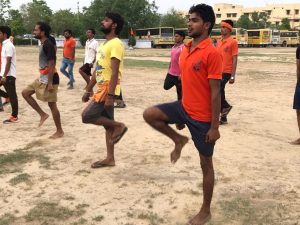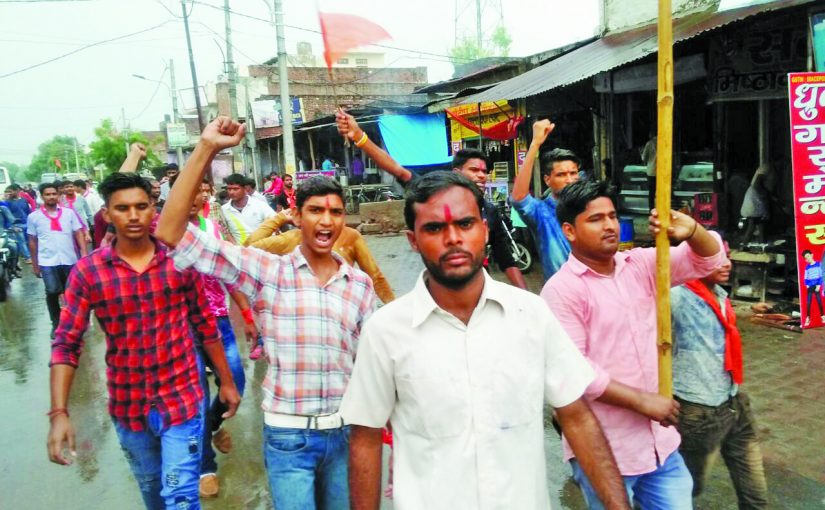EXTREMIST: Ram Kumar, left, and Gaurav Sharma at a leadership camp for Hindu activists in Govardhan in June
An article by Annie Gowen of the Washington Post on August 27, 2018, has exposed multiple problems created by gender disparities in India. Young ‘surplus’ men are gravitating towards right-wing organisations that promote violence
The two young men at the leadership camp were soft-spoken yet assured, from well-off families, wearing aviator sunglasses and flip-flops.
The right-wing activists say they have beaten men they suspected of violating core Hindu beliefs and threatened interfaith couples because they fear Muslims are stealing their women. They say they’re ready to kill for their faith if necessary.
“Even if a life is lost, we don’t care,” said Ram Kumar, 23.
It’s been a summer of rage in India. Dozens have been killed by lynch mobs, and extremist Hindus continue to assault and kill others, many of them Muslims. In the latest viral video, religious pilgrims angered over a minor traffic incident used sticks to demolish a car as police looked on.
Much blame has been cast on India’s governing Hindu nationalist Bharatiya Janata Party (BJP) and Prime Minister Narendra Modi, with critics charging that they have encouraged violence by Hindu extremists. But India’s problem of male rage has roots beyond the strident Hindu nationalism embraced by the current government.
India has more than 600 million people under 25, and they have greater access to technology and education than ever before. Yet millions have little hope of finding decent jobs, and a “bachelor bomb” of more than 37 million surplus men — a legacy of generations of a preference for sons and aborting female fetuses — threatens social stability for decades.
“People are frustrated that they are not being able to get jobs,” a leader from Modi’s party, Vasundhara Raje, told the channel CNN-News18. “There is angst, which is spreading across communities and people. . . . It’s a reaction to their circumstances.”
More than 1 million job seekers enter the labor market each month, many with inadequate job skills, but the country generated only 1.8 million additional jobs last year, according to the Center for Monitoring Indian Economy, a research company. Modi says the number of new jobs last year was closer to 7 million.
Without solid prospects, many young men are gravitating to India’s growing right-wing nationalist organizations, where they find a sense of purpose.
Over time, a stereotype of a right-wing troll has emerged — keyboard jockeys with too much time on their hands, sitting in their childhood bedrooms furiously tweeting about every perceived slight to Hinduism and Modi.
This summer, Kumar attended a leadership camp sponsored by the Hindu nationalist World Hindu Council, where he learned to protect cows, which Hindus regard as sacred, protect women’s modesty and prevent outsiders from converting Hindus to other faiths. The youths did military drills in the baking heat, slept in spartan concrete dorm rooms and ate lentils and rice.
Kumar, a college graduate who runs a tent rental company, and Gaurav Sharma, 22, a law student, grew up in Agra, the city of the Taj Mahal, which they see not as an ethereal white monument but as a reminder of the Mughal invaders who subjugated India’s Hindus.
Kumar said that as a boy, he was shy. But after joining the Hindu nationalist movement, he said, “I have a strange sense of confidence now. The group has taught us what is right, what we need to do for society.”
Before long, he said, he was out on the streets chasing down and threatening interfaith couples, conducting the moral policing he feels is necessary because Muslim men allegedly seduce girls “as young as 14.” The Hindu activists call it “love jihad.”
Kumar said he also prowls the streets at night, searching for cattle traders who might be illegally smuggling cows for slaughter. Recently, he said, he and five others stopped a truck transporting cows and beat the Muslim driver, who pleaded for his life. The man was saved only by the arrival of the police, Kumar said.
“I was raging,” Kumar said. “If I had a pistol, I would have killed him.”
Sharma said he, too, has participated in assaults, punching one suspected cattle smuggler in the face. Elders have since shown him how to administer a beating without leaving marks on his victim.
“We have been taught to not hit the head and chest — that can be fatal,” he said. “We beat them in such a way so they get these serious, silent injuries — on the backs, on the legs — so they do not die. Otherwise, there will be a case against us.”
Since the BJP came to power in their state, Uttar Pradesh, led by the Hindu monk Yogi Adityanath, they do not fear being held accountable by the authorities.
“Earlier, there was a fear that the government would arrest us, but now with the Yogi government, we don’t have any fear,” Sharma said. “Even if a smuggler is killed during a fight, we don’t have to worry about it.”
He continued, “All these BJP leaders, they’ve said: ‘Do what you want to do about cow protection. Don’t worry. If there is any problem, we are there for you.’ ”
Modi has said that state governments should deal sternly with these “cow vigilantes” and that the government is committed to upholding the law, but other BJP politicians have sent a different message, meeting with or congratulating the alleged killers.

The young men harbour a deep sense of victimization and spend a lot of time on Hindu-pride-focused WhatsApp groups and alternate-history websites that recount the glories of India’s ancient civilization before the Mughal and British invaders imposed, as Modi puts it, 1,200 years of servitude. Critics say social media is deepening the division between Hindus and Muslims in India that existed before the bloody partition of India in 1947 that created a separate country for Muslims, and ultimately an Islamic republic in Pakistan.
“Our parents never told us anything bad about Muslims. But in madrassas, they learn that Hindus are bad,” Sharma said. “We will tell the next generations how bad these people are.”
Sharma and his peers face stiff competition for careers because they attended schools where classes are taught in Hindi and because they know only a few phrases of English, the lingua franca of aspirational India. Many of their classmates are struggling, selling vegetables or doing menial labor. Thirty classmates joined the military.
Kumar plans on having a traditional family, if only to have babies and “contribute to the population.”
“The Hindu population,” Sharma clarified.
Others in their generation may not get the chance. Demographer Christophe Guilmoto estimates that, because of the gender imbalance, 40 million surplus men in India will remain single between 2020 and 2080.
“There is a saying, ‘Behind every successful man is a woman’? But you don’t need women. You can leave them behind and achieve success in life,” Sharma said. For Sharma, the love of his life married someone else. He said he still regrets that he did not ask his parents for permission to marry her. But nobody in his family had ever had a “love marriage” — always arranged unions.
Now he has made a “final decision,” to the dismay of his parents, to remain single and devote himself to the Hindu nationalist cause — just like his idol, Modi, who, after an early marriage, has long embraced the bachelor lifestyle as a campaigner for Mother India.
Courtesy: Washington Post
